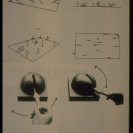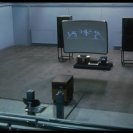Points of View was a 'theatre of signs' with both stage and protagonists being provided by a three-dimensional computer graphics simulation that was video projected onto a large screen in front of a seated audience. The action of the work was controlled by one member of the audience using two specially made joysticks. Embodying techniques developed for flight simulation, this work gave the operator the ability to interactively move his virtual point of view 360 degrees around the stage, 90 degrees up and down from ground level to aerial view, and forwards and backwards from a far distance to the centre of the stage.
The representation of the actors on the stage was derived from the ancient Egyptian alphabet - each figure was a hieroglyphic character. This constellation of signs was used to articulate a world model with an underlying set of physical and conceptual relationships. Sixteen sound tracks - mostly spoken texts - were interactively linked to the image via the same joystick that controlled the visual movements. Functioning like an audio mixer, this modulated the relative volume of the various voices with respect to the changing spatial positions taken by the viewer. Here again an intrinsic conceptual structure was articulated in the spatial mapping of these sound tracks to four positions on four levels of a semi-sphere.
reconstructed Points of View (1999):
Faced with the occasion to show Points of View 16 years after its creation, it became clear that the restitution of the original hardware and software would be much more difficult than simply reconstructing and reprogramming the complete work on a currently available platform. Almost all the many analog components of the original work have been more efficiently (and reliably) implemented digitally, especially the joystick technology and the audio recordings. On the other hand, the much better performance and resolution of present day graphics technology had to be tuned down to simulate the low resolution and slow frame rate of the Apple II computer on which this work was first created, to maintain its original visual aesthetics.
This reconstruction strategy points to an overall solution to the problem of the long term conservation of computer based artworks. Instead of trying to maintain the original technological configuration (with the ensueing and often insurmountable difficulties of obolescence and high cost), an exact documentation and description of the original work allows it to be reconstructed at any time on the then available hardware/software platforms, so that an exact simulation of the appearance and functionality of the original work can be achieved.
Credits:
Software: Larry Abel (1983), Torsten Ziegler (1999)
Hardware: Tat van Vark and Charly Jungbauer (1983), Armin Steinke (1999)
Produced under the auspices of the Mickery Theater, Amsterdam, Netherlands.
Exhibitions:
1983: Mickery Theater, Amsterdam, Netherlands; Kijkhuis, The Hague, Netherlands; Centrum t'Hoogt, Utrecht, Netherlands; De Lantaren, Rotterdam, Netherlands.
1983/84: Apollohuis, Eidhoven, Netherlands.
1999: Stand der Dinge / Virtuelle Entwicklungen, Künstlerhaus, Vienna, Austria.









